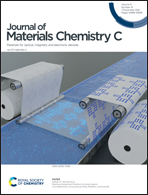Boron dopant simultaneously achieving nanostructure control and electronic structure tuning of graphitic carbon nitride with enhanced photocatalytic activity†
Abstract
Graphitic carbon nitride (g-C3N4) has been widely studied for photocatalysis due to its suitable band structure, tunable bandgap and low cost. Nevertheless, the photocatalytic performance of bulk g-C3N4 is poor because of the severe charge recombination. Herein, a facile two-step thermal treatment approach is proposed to prepare boron doped g-C3N4 with adjoined nanotubular structures by adding a small amount of H3BO3 in urea. Interestingly, nanostructure evolution of the g-C3N4 from nanosheets to adjoined nanotubes can be obtained by tuning the amount of H3BO3. The obtained g-C3N4 adjoined nanotubes with optimal boron doping exhibit an excellent photocatalytic hydrogen production rate of 3.8 mmol g−1 h−1, which is approximately 2 times higher than its pristine g-C3N4 counterpart. Furthermore, a high apparent quantum efficiency of 14.46% is achieved at 420 nm. Systematical studies reveal that the enhanced photocatalytic hydrogen evolution performance stems from the synergistic effect of boron doping and adjoined nanotube structures that promotes charge transport and separation. The new finding provides a simple strategy to achieve simultaneous doping and nanostructured control for the design of efficient photocatalysts.



 Please wait while we load your content...
Please wait while we load your content...